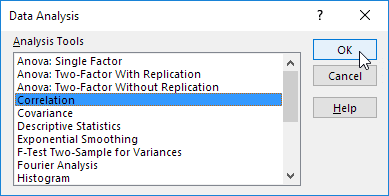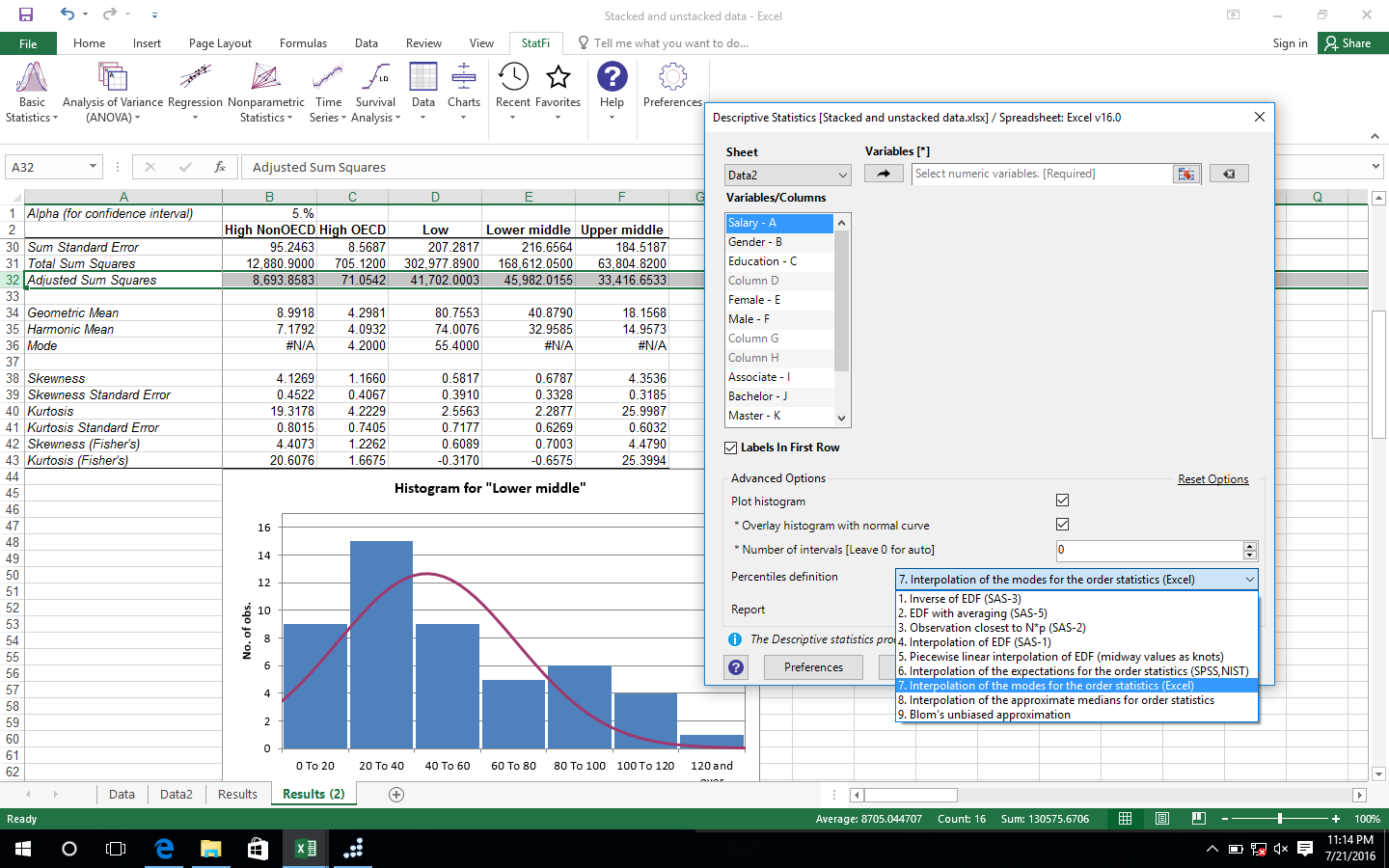If the Data Analysis command is not available. If you're using Excel for Mac, in the file menu go to Tools > Excel Add-ins. In the Add-Ins box. The Descriptive Statistics analysis tool generates a report of univariate statistics for data in the input range, providing information about the central tendency and variability of your data. Where is the Data Analysis Tool for Excel 2011? Or How do I perform descriptive statistics? Data Analysis tool - Excel 2011 for Macs Where is the Data Analysis Tool for Excel 2011? Or How do I perform descriptive statistics? I tried downloading the add-on but I don't know where to download it to. Excel for Office 365 Excel for Office 365 for Mac Excel 2019 Excel 2016 Excel 2019 for Mac Excel 2013 Excel 2010 Excel 2007 Excel 2016 for Mac Excel for Mac 2011 More. Less If you need to develop complex statistical or engineering analyses, you can save steps and time by using the Analysis ToolPak. OriginPro 8.7 is a program to perform data analysis, statistics and graphing. The program provides the most frequently used advanced statistical tests. It includes expanded parametric hypothesis testing tools, expanded nonparametric hypothesis testing tools, survival analysis tools, ROC curves and expanded descriptive statistics tools. Descriptive Statistics with Excel. Excel 2007/2010. The Analysis Group and then selecting Data Analysis. Choose Descriptive Statistics from the list. (Excel 2008 for the Mac is configured much like Excel 2003, while Excel 2011 for the Mac is a hybrid of this version and newer ones above). I teach statistics at a university and use EXCEL. My MAC/Apple student users can't find the Data Analysis Tool Pack. I have looked and found one reference to MAC EXCEL 2001 for installing KB276444. Fast Statistics is an easy to use Statistical and Graphical Analysis tool for MS Excel, it can work as an Excel add-in, perform from basic data manipulations to the most advanced statistical analyses and produce sophisticated reports and charts.
- Download Descriptive Statistics Analysis Tool Excel For Mac
- Data Analysis Tool Excel For Mac
- Download Descriptive Statistics Analysis Tool Excel For Mac Free
- Business Analysis Tool
Download Descriptive Statistics Analysis Tool Excel For Mac

I wouldn't rely on someone else's judgement to make this buying decision. You can go to: http://manuals.info.apple.com/enUS/Formulas_and_Functions_UserGuide.pdf and download the Formulas and Functions User Guide to see if the functions you need are there. If you still aren't sure, you can download the demo version of Numbers '09 and make some tests. I think that I can safely say that although Numbers has more Functions in '09 than '08 had, there still will be gaps between what you find in Numbers and in the Analysis Tools of Excel.
Jerry
Perhaps the most common Data Analysis tool that you’ll use in Excel is the one for calculating descriptive statistics. To see how this works, take a look at this worksheet. It summarizes sales data for a book publisher.
Data Analysis Tool Excel For Mac
In column A, the worksheet shows the suggested retail price (SRP). In column B, the worksheet shows the units sold of each book through one popular bookselling outlet. You might choose to use the Descriptive Statistics tool to summarize this data set.
To calculate descriptive statistics for the data set, follow these steps:
Download Descriptive Statistics Analysis Tool Excel For Mac Free

Business Analysis Tool
Click the Data tab’s Data Analysis command button to tell Excel that you want to calculate descriptive statistics.
Excel displays the Data Analysis dialog box.
In Data Analysis dialog box, highlight the Descriptive Statistics entry in the Analysis Tools list and then click OK.
Best Snipping Tool for Mac If you want a snipping tool packed with additional features, download Skitch, from the creators of Evernote. Skitch is a free snipping tool app for Macs that also allows you to easily draw arrows, boxes, add text, resize the image, and much more. Apr 26, 2015 The first Snipping Tool alternative for Mac that you can use is Apowersoft Mac Screenshot. This program is designed and created to fit in any device that runs on Mac OS X. This program is designed and created to fit in any device that runs on Mac OS X. Best snipping tool for mac. How can the answer be improved? Nov 17, 2017 Snipping tool mac is the source of this information. Please go through it and find more information. Sep 12, 2017 4:57 AM Reply Helpful. Thread reply - more options. Link to this Post; User profile for user: lasanthak lasanthak User level: Level 1.
Excel displays the Descriptive Statistics dialog box.
In the Input section of the Descriptive Statistics dialog box, identify the data that you want to describe.
To identify the data that you want to describe statistically: Click the Input Range text box and then enter the worksheet range reference for the data. In the case of the example worksheet, the input range is $A$1:$C$38. Note that Excel wants the range address to use absolute references — hence, the dollar signs.
To make it easier to see or select the worksheet range, click the worksheet button at the right end of the Input Range text box. When Excel hides the Descriptive Statistics dialog box, select the range that you want by dragging the mouse. Then click the worksheet button again to redisplay the Descriptive Statistics dialog box.
To identify whether the data is arranged in columns or rows: Select either the Columns or the Rows radio button.
To indicate whether the first row holds labels that describe the data: Select the Labels in First Row check box. In the case of the example worksheet, the data is arranged in columns, and the first row does hold labels, so you select the Columns radio button and the Labels in First Row check box.
In the Output Options area of the Descriptive Statistics dialog box, describe where and how Excel should produce the statistics.
To indicate where the descriptive statistics that Excel calculates should be placed: Choose from the three radio buttons here — Output Range, New Worksheet Ply, and New Workbook. Typically, you place the statistics onto a new worksheet in the existing workbook. To do this, simply select the New Worksheet Ply radio button.
To identify what statistical measures you want calculated: Use the Output Options check boxes. Select the Summary Statistics check box to tell Excel to calculate statistical measures such as mean, mode, and standard deviation. Select the Confidence Level for Mean check box to specify that you want a confidence level calculated for the sample mean.
Note: If you calculate a confidence level for the sample mean, you need to enter the confidence level percentage into the text box provided. Use the Kth Largest and Kth Smallest check boxes to indicate you want to find the largest or smallest value in the data set.
After you describe where the data is and how the statistics should be calculated, click OK. Here are the statistics that Excel calculates.
Statistic Description Mean Shows the arithmetic mean of the sample data. Standard Error Shows the standard error of the data set (a measure of the
difference between the predicted value and the actual value).Median Shows the middle value in the data set (the value that
separates the largest half of the values from the smallest half of
the values).Mode Shows the most common value in the data set. Standard Deviation Shows the sample standard deviation measure for the data
set.Sample Variance Shows the sample variance for the data set (the squared
standard deviation).Kurtosis Shows the kurtosis of the distribution. Skewness Shows the skewness of the data set’s distribution. Range Shows the difference between the largest and smallest values in
the data set.Minimum Shows the smallest value in the data set. Maximum Shows the largest value in the data set. Sum Adds all the values in the data set together to calculate the
sum.Count Counts the number of values in a data set. Largest(X) Shows the largest X value in the data set. Smallest(X) Shows the smallest X value in the data set. Confidence Level(X) Percentage Shows the confidence level at a given percentage for the data
set values.
Here is a new worksheet with the descriptive statistics calculated.
Previous Snapshot Area – Select the option in case you want to include the same portion as it was with the earlier screenshot. https://communicationgol341.netlify.app/snapping-tool-for-mac.html.